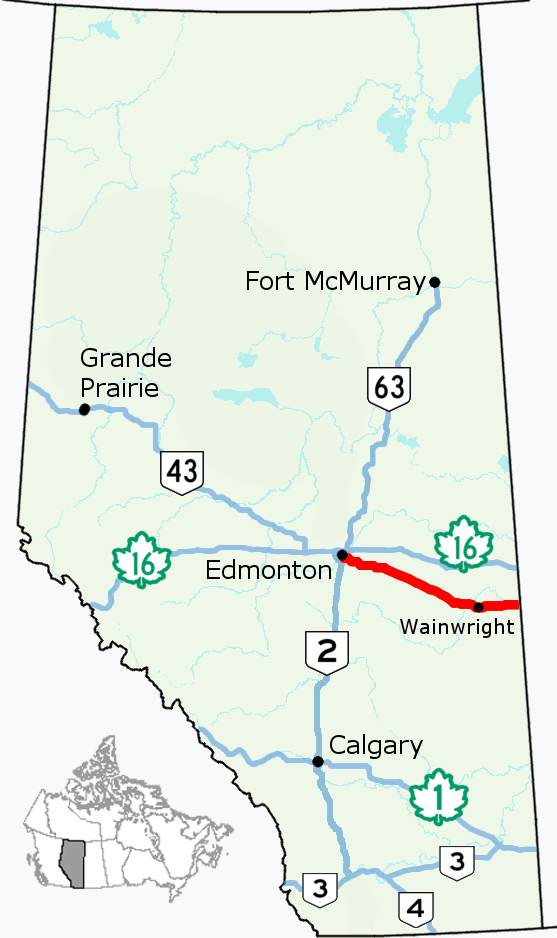|
Poundmaker Trail
Poundmaker Trail is a interprovincial highway in Western Canada that runs from Edmonton, Alberta, to North Battleford, Saskatchewan, following Alberta Highway 14 and Saskatchewan Highway 40. The highway is named after Pitikwahanapiwiyin ( c. 1842–July 4, 1886), commonly known as Poundmaker, a Plains Cree chief known as a peacemaker and defender of his people. The former alignment of Poundmaker Trail followed Saskatchewan Highway 16A through Battleford and across the North Saskatchewan River along original Battlefords Bridge via Finlayson Island. Around 2003, in conjunction with the Battlefords Bridge being twinned along the Highway 4/ 16/ 40 corridor, the original bridges were closed to motor vehicles, and Highway 16A was decommissioned. Junction list ;Alberta : southeast of Edmonton : southeast of Sherwood Park : in Viking : in Wainwright : south of Lloydminster ;Saskatchewan : east of Cut Knife : east of Battleford : in Battleford See al ... [...More Info...] [...Related Items...] OR: [Wikipedia] [Google] [Baidu] |
Alberta Highway 14
Alberta Provincial Highway No. 14, commonly referred to as Highway 14, is an east-west highway in central Alberta, Canada. It stretches from Edmonton through Wainwright to the Alberta–Saskatchewan border, running parallel to the more northern Highway 16. Highway 14 is about long. Along with Saskatchewan Highway 40 (with which it connects at the boundary), it forms part of the Poundmaker Trail, named after Chief Poundmaker of the Cree. Route description Highway 14 begins in south Edmonton as a freeway named Whitemud Drive at the Calgary Trail / Gateway Boulevard interchange, linking to Highway 2. It travels east for along Whitemud Drive through neighbourhoods of southeast Edmonton until reaching the Anthony Henday Drive ring road, with which it is concurrent for . Leaving the city, the highway veers east and intersects Highway 21 before the divided highway ends west of South Cooking Lake. It continues east toward Tofield ... [...More Info...] [...Related Items...] OR: [Wikipedia] [Google] [Baidu] |
Plains Cree People
Plains Indians or Indigenous peoples of the Great Plains and Canadian Prairies are the Native American tribes and First Nation band governments who have historically lived on the Interior Plains (the Great Plains and Canadian Prairies) of North America. While hunting-farming cultures have lived on the Great Plains for centuries prior to European contact, the region is known for the horse cultures that flourished from the 17th century through the late 19th century. Their historic nomadism and armed resistance to domination by the government and military forces of Canada and the United States have made the Plains Indian culture groups an archetype in literature and art for Native Americans everywhere. The Plains tribes are usually divided into two broad classifications which overlap to some degree. The first group became a fully nomadic horse culture during the 18th and 19th centuries, following the vast herds of American bison, although some tribes occasionally engaged in ag ... [...More Info...] [...Related Items...] OR: [Wikipedia] [Google] [Baidu] |
Alberta Provincial Highways, 1–216 Series
Alberta ( ) is one of the thirteen provinces and territories of Canada. It is part of Western Canada and is one of the three prairie provinces. Alberta is bordered by British Columbia to the west, Saskatchewan to the east, the Northwest Territories (NWT) to the north, and the U.S. state of Montana to the south. It is one of the only two landlocked provinces in Canada (Saskatchewan being the other). The eastern part of the province is occupied by the Great Plains, while the western part borders the Rocky Mountains. The province has a predominantly continental climate but experiences quick temperature changes due to air aridity. Seasonal temperature swings are less pronounced in western Alberta due to occasional Chinook winds. Alberta is the fourth largest province by area at , and the fourth most populous, being home to 4,262,635 people. Alberta's capital is Edmonton, while Calgary is its largest city. The two are Alberta's largest census metropolitan areas. More than half of Al ... [...More Info...] [...Related Items...] OR: [Wikipedia] [Google] [Baidu] |


